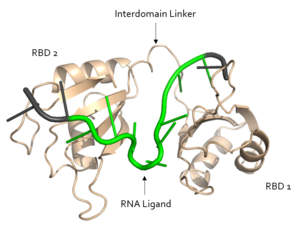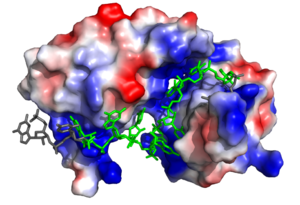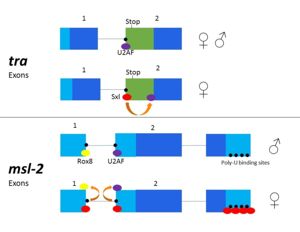User:Kyle Burton/Sandbox1
From Proteopedia
(Difference between revisions)
| Line 6: | Line 6: | ||
== Structure == | == Structure == | ||
| - | |||
[[Image:Sex lethal protein electrostatic surface representation.png|300px|left|thumb| '''Figure 2.''' Sxl showing the electropositive binding pocket and the bound RNA ligand. Pre-mRNA residues binding to Sxl shown in green, non-binding residues shown in grey. Structure shown is [https://www.rcsb.org/structure/1b7f PDB:1b7f]. Figure created in PyMol.]] | [[Image:Sex lethal protein electrostatic surface representation.png|300px|left|thumb| '''Figure 2.''' Sxl showing the electropositive binding pocket and the bound RNA ligand. Pre-mRNA residues binding to Sxl shown in green, non-binding residues shown in grey. Structure shown is [https://www.rcsb.org/structure/1b7f PDB:1b7f]. Figure created in PyMol.]] | ||
Sxl is composed of two asymmetric RNA binding domains (RBD1 and RBD2) which recognize a poly-uridine site in the pre-mRNA transcript<ref name="Handa"/>. <scene name='78/783145/Secondary_structure/3'>Both RBDs</scene> are comprised of two [https://en.wikipedia.org/wiki/Alpha_helix alpha helices] and one antiparallel four-stranded [https://en.wikipedia.org/wiki/Beta_sheet β sheet]<ref name="Handa"/> containing the [https://en.wikipedia.org/wiki/RNA_recognition_motif RNA recognition motif](Fig. 1). The β sheets face each other, lining the V-shaped cleft<ref name="Handa"/>, shown in sand in Fig. 1. The inter-domain linker, shown in sand in Fig. 1, forms a distorted 3<sub>10</sub> helix which helps form the V-shaped cleft into which the pre-mRNA sequence binds<ref name="Handa"/><ref name="Black">doi: 10.1146/annurev.biochem.72.121801.161720</ref>. Sxl binds to UGUUUUUUU sequence of GUUGUUUUUUUU in the ''tra'' pre-mRNA<ref name="Handa"/><ref name="Black"/>. RBD1 binds U6-U11 and RBD2 binds U3, G4, and U5. Figure 1 shows bound pre-mRNA residues in green and non-bound pre-mRNA residues in grey. Although the two RBDs do not interact with each other, this nine-ribonucleotide sequence must be recognized continuously to allow Sxl to bind, preventing U2AF from binding at the 3’ splice site<ref name="Handa"/>. The binding of Sxl to the pre-mRNA occurs in an electropositive pocket (shown in blue in Fig. 2) due to extensive interactions with the RNA phosphate backbone and negatively charged residues<ref name="Handa"/>. There is variation in other drosopholids' ''sxl'' gene because non-RBD residues are not essential to Sxl's function, but the RBD residues are highly conserved<ref name="Penalva"/>. | Sxl is composed of two asymmetric RNA binding domains (RBD1 and RBD2) which recognize a poly-uridine site in the pre-mRNA transcript<ref name="Handa"/>. <scene name='78/783145/Secondary_structure/3'>Both RBDs</scene> are comprised of two [https://en.wikipedia.org/wiki/Alpha_helix alpha helices] and one antiparallel four-stranded [https://en.wikipedia.org/wiki/Beta_sheet β sheet]<ref name="Handa"/> containing the [https://en.wikipedia.org/wiki/RNA_recognition_motif RNA recognition motif](Fig. 1). The β sheets face each other, lining the V-shaped cleft<ref name="Handa"/>, shown in sand in Fig. 1. The inter-domain linker, shown in sand in Fig. 1, forms a distorted 3<sub>10</sub> helix which helps form the V-shaped cleft into which the pre-mRNA sequence binds<ref name="Handa"/><ref name="Black">doi: 10.1146/annurev.biochem.72.121801.161720</ref>. Sxl binds to UGUUUUUUU sequence of GUUGUUUUUUUU in the ''tra'' pre-mRNA<ref name="Handa"/><ref name="Black"/>. RBD1 binds U6-U11 and RBD2 binds U3, G4, and U5. Figure 1 shows bound pre-mRNA residues in green and non-bound pre-mRNA residues in grey. Although the two RBDs do not interact with each other, this nine-ribonucleotide sequence must be recognized continuously to allow Sxl to bind, preventing U2AF from binding at the 3’ splice site<ref name="Handa"/>. The binding of Sxl to the pre-mRNA occurs in an electropositive pocket (shown in blue in Fig. 2) due to extensive interactions with the RNA phosphate backbone and negatively charged residues<ref name="Handa"/>. There is variation in other drosopholids' ''sxl'' gene because non-RBD residues are not essential to Sxl's function, but the RBD residues are highly conserved<ref name="Penalva"/>. | ||
| Line 40: | Line 39: | ||
=== ''Msl-2'' === | === ''Msl-2'' === | ||
| - | |||
Msl-2 is responsible for [https://en.wikipedia.org/wiki/Dosage_compensation dosage compensation] of X chromosomes in fruit flies<ref name="Bashaw"/><ref name="Kelley"/>. The alternative splicing of ''msl-2'' is reliant on Sxl binding to both the 5' and 3' splice sites (Fig. 3). Sxl binds at the 3' splice site, replacing U2AF as in ''tra'' splicing. Sxl also competes with [http://www.uniprot.org/uniprot/Q26281 Rox8], which binds to the first intron. As a result, Sxl prevents splicing of the first intron of the ''msl-2'' primary transcript<ref name="Georgiev"/>. Sxl also binds to the poly- U sequences of the 3' UTR to repress translation (Fig.3), leading to female expression<ref name="Kelley"/><ref>PMID: 9570314</ref><ref name="Penalva"/>. When Sxl targets ''msl-2'', the first intron is retained<ref name="Black"/><ref name="Georgiev"/>. However, the retained intron is in the [https://en.wikipedia.org/wiki/Untranslated_region 5' UTR] and does not affect the reading frame<ref name="Black"/>. When ''msl-2'' is expressed, the X chromosome's transcription is repressed. In male fruit flies, ''msl-2'' must be inactivated to allow increased X chromosome transcription<ref name="Georgiev"/>. As the expression of ''msl-2'' is exclusively required for male fruit fly development, any mutation in Sxl protein which causes splicing and activation of the ''msl-2'' gene in females leads to female fly death by hyperexpression of both X chromosomes<ref name="Georgiev"/>. | Msl-2 is responsible for [https://en.wikipedia.org/wiki/Dosage_compensation dosage compensation] of X chromosomes in fruit flies<ref name="Bashaw"/><ref name="Kelley"/>. The alternative splicing of ''msl-2'' is reliant on Sxl binding to both the 5' and 3' splice sites (Fig. 3). Sxl binds at the 3' splice site, replacing U2AF as in ''tra'' splicing. Sxl also competes with [http://www.uniprot.org/uniprot/Q26281 Rox8], which binds to the first intron. As a result, Sxl prevents splicing of the first intron of the ''msl-2'' primary transcript<ref name="Georgiev"/>. Sxl also binds to the poly- U sequences of the 3' UTR to repress translation (Fig.3), leading to female expression<ref name="Kelley"/><ref>PMID: 9570314</ref><ref name="Penalva"/>. When Sxl targets ''msl-2'', the first intron is retained<ref name="Black"/><ref name="Georgiev"/>. However, the retained intron is in the [https://en.wikipedia.org/wiki/Untranslated_region 5' UTR] and does not affect the reading frame<ref name="Black"/>. When ''msl-2'' is expressed, the X chromosome's transcription is repressed. In male fruit flies, ''msl-2'' must be inactivated to allow increased X chromosome transcription<ref name="Georgiev"/>. As the expression of ''msl-2'' is exclusively required for male fruit fly development, any mutation in Sxl protein which causes splicing and activation of the ''msl-2'' gene in females leads to female fly death by hyperexpression of both X chromosomes<ref name="Georgiev"/>. | ||
== Relevance == | == Relevance == | ||
| - | As Sxl functions as a splicing repressor, it may give insight into the effects of varying mechanisms of alternate splicing both in flies and other species. Sxl may also lead to understanding of human alternative splicing factors. As an RNA binding protein, research regarding Sxl may contribute to the understanding of enzymes with RNA recognition motifs. The Sxl RNP motif of RBD1 is also conserved in the ELAV family of proteins<ref name="Handa"/>. Sxl is only one of many proteins which regulate dosage compensation, but is one that is observed in XX/XY systems, and thus could lead to better comprehension of dosage compensation in species with similar sex determination systems. | + | As Sxl functions as a splicing repressor, it may give insight into the effects of varying mechanisms of alternate splicing both in flies and other species. Sxl may also lead to understanding of human alternative splicing factors. As an RNA binding protein, research regarding Sxl may contribute to the understanding of enzymes with RNA recognition motifs. The Sxl RNP motif of RBD1 is also conserved in the ELAV family of proteins<ref name="Handa"/><ref>PMID: 9299339</ref>. Sxl is only one of many proteins which regulate dosage compensation, but is one that is observed in XX/XY systems, and thus could lead to better comprehension of dosage compensation in species with similar sex determination systems. |
</StructureSection> | </StructureSection> | ||
== References == | == References == | ||
<references/> | <references/> | ||
Revision as of 23:14, 22 April 2018
| |||||||||||
References
- ↑ 1.00 1.01 1.02 1.03 1.04 1.05 1.06 1.07 1.08 1.09 1.10 1.11 1.12 1.13 1.14 Handa N, Nureki O, Kurimoto K, Kim I, Sakamoto H, Shimura Y, Muto Y, Yokoyama S. Structural basis for recognition of the tra mRNA precursor by the Sex-lethal protein. Nature. 1999 Apr 15;398(6728):579-85. PMID:10217141 doi:10.1038/19242
- ↑ 2.0 2.1 2.2 2.3 2.4 Penalva L, Sanchez L. RNA Binding Protein Sex-Lethal (Sxl) and Control of Drosophila Sex Determination and Dosage Compensation. Microbiol Mol Biol Rev.;67(3):343-356. doi: 10.1128/MMBR.67.3.343–359.2003
- ↑ 3.0 3.1 3.2 Bashaw GJ, Baker BS. The msl-2 dosage compensation gene of Drosophila encodes a putative DNA-binding protein whose expression is sex specifically regulated by Sex-lethal. Development. 1995 Oct;121(10):3245-58. PMID:7588059
- ↑ 4.0 4.1 4.2 Kelley RL, Solovyeva I, Lyman LM, Richman R, Solovyev V, Kuroda MI. Expression of msl-2 causes assembly of dosage compensation regulators on the X chromosomes and female lethality in Drosophila. Cell. 1995 Jun 16;81(6):867-77. PMID:7781064
- ↑ 5.00 5.01 5.02 5.03 5.04 5.05 5.06 5.07 5.08 5.09 5.10 5.11 5.12 5.13 Black DL. Mechanisms of alternative pre-messenger RNA splicing. Annu Rev Biochem. 2003;72:291-336. doi: 10.1146/annurev.biochem.72.121801.161720., Epub 2003 Feb 27. PMID:12626338 doi:http://dx.doi.org/10.1146/annurev.biochem.72.121801.161720
- ↑ 6.0 6.1 6.2 6.3 6.4 Georgiev P, Chlamydas S, Akhtar A. Drosophila dosage compensation: males are from Mars, females are from Venus. Fly (Austin). 2011 Apr-Jun;5(2):147-54. Epub 2011 Apr 1. PMID:21339706
- ↑ Lee AL, Volkman BF, Robertson SA, Rudner DZ, Barbash DA, Cline TW, Kanaar R, Rio DC, Wemmer DE. Chemical shift mapping of the RNA-binding interface of the multiple-RBD protein sex-lethal. Biochemistry. 1997 Nov 25;36(47):14306-17. doi: 10.1021/bi970830y. PMID:9398148 doi:http://dx.doi.org/10.1021/bi970830y
- ↑ Gebauer F, Merendino L, Hentze MW, Valcarcel J. The Drosophila splicing regulator sex-lethal directly inhibits translation of male-specific-lethal 2 mRNA. RNA. 1998 Feb;4(2):142-50. PMID:9570314
- ↑ Inoue M, Muto Y, Sakamoto H, Kigawa T, Takio K, Shimura Y, Yokoyama S. A characteristic arrangement of aromatic amino acid residues in the solution structure of the amino-terminal RNA-binding domain of Drosophila sex-lethal. J Mol Biol. 1997 Sep 12;272(1):82-94. PMID:9299339 doi:10.1006/jmbi.1997.1213



